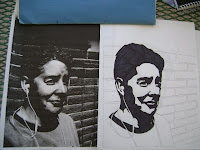Surface Design Play Day:
We had a "play" day in Mixed media where we explored a little bit of Surface Design on a yard of Pellon Interfacing (non-fusible). ;-)
Fabric paints were made available to us and the colors and patterns created by the class were varied and amazing. {Yep, I'm a ninny - I didn't get pictures. Sorry.}
{Thanks are offered again to my table & lunch mate who brought in and allowed me to use her extensive collection of paints!}
However, here's the one I painted.
I folded it accordion-style and painted some parts, soaked other parts and got a surprise bit of red from one of the clothes pins I used to keep it folded. {grin}
Oh - and it was suggested we could use our painted pellon in our Plaiting project - which I did (although I wasn't particularly tickled with the results).
What is plaiting? That's one of the up-n-coming blog posts. ;-)
Mikale seemed to liked my Surface Design efforts:

Educational Fiber-esque Videos:
Well, I thought I'd be able to offer links to some of the stellar, art/inspirational videos the teacher showed us but I can't even find references to most of them online or on Netflix. {sigh} I would guess they are available in the Pima College...well, two of them are:
"Textile Magicians Japan" The video liner description sums it up very nicely: "An exceptional and poetic voyage through the worlds of five contemporary Japanese textile artists living and working in harmony with nature in the cedar forests north of Kyoto". Their art seemed well-considered and their creative actions had a calm, reflective quality. The resulting works were inspiring but and sometimes surprising.
- Hiroyuki Shindo does amazing things with Indigo.
- Masakazu and Naomi Kobayashi do amazing things with string/lace/weaving and large art installations.
- Chiyoko Tanaka - Dying handwoven fabric by grinding soil into/through it. Wow.
- Jun Tomita - oh, the painted weavings he creates!
This adventurous blogger travelled to Kyoto and met several of the artists featured in the film!
"Blue Alchemy" by Mary Lance was a fascinating film about the various ways that people extract indigo and how the dye is used. I want to see it again! Here's the trailer for the film.
The Return of the Corn Mother Exhibit:
The Corn Mother Exhibit was in one of the Pima College Galleries during the Spring Semester as Pima College Board Member Dr. Sylvia Lee and her mother Sofia were named 2013 Corn Mothers.
The Corn Mother Website describes today's Corn Mothers as: "women who live, study, and work in the Southwest: Arizona, Colorado, New Mexico, and northern Texas. Some are native, indigenous to this region. Others have journeyed here, as thousands have done for centuries, from other places. They all share an ability to pull from the past all that is sacred and holy, and to create a future that is filled with promise."
Our class went to explore this inspiring multi-generational/cultural exhibit and our instructor asked us to write a short paper answering 3 questions as though we were going to be named a Corn Mother:
1. Why you are a Corn Mother?
I believe my current educational endeavors, pursuing a Fiber Arts Degree, could be viewed as a culmination of my journey as a Corn Mother. I was born in the Southwest, here in Tucson. My parents set an excellent example of love, honor, ongoing education, thrift, humor, the basics of religion, and applied equality. These became core fibers in my life. As I have grown and continued to learn those fibers are strengthened and joined by heartful experience: love, discovery, extreme work ethic, illness, care-taking, loss, spirituality, memories, friendship, disappointment, hope, and laughter. It is hard to describe or quantify this journey. However I can say there is much to learn, my current path is feeding my soul, and I laugh much more often in this part of my journey.
2. Life Quote:
I have two favored quotes that remind me to have fun, retain hope, and keep an open mind:
"Wrinkles should merely indicate where smiles have been." Mark Twain
"The freethinking of one age is the common sense of the next." Matthew Arnold
3. Where would you be Photographed?
There are many locations around Tucson at which I would choose to be photographed. I considered that I might like to be photographed at Pima College - the site of my current educational explorations.
I also considered a photograph at the Arizona-Sonora Desert Museum amongst the charming and fierce little birds in the Hummingbird exhibit.
However, I would probably choose to be photographed at sunset, sitting on the hood of my truck in the pull out on the West side of the Tucson Mountains, just down the hill from Gates Pass. It is a place I have visited many times throughout my life. I find it soothes my mind, inspires appreciation of our lovely desert/sky, and it reminds me to slow down and mind Life and the road as I sit and watch people drive through Gates Pass.
Here's a video someone made going down the backside of Gates Pass in the Tucson mountains - the pullout I describe is at the 1 minute mark in the video (on the left side of the road).
Lastly, it's not the view from Gates Pass, but here are a couple of Arizona Sunsets from the middle of Tucson {Ha - as if the telephone poles/lines weren't a not-Gates Pass giveaway!}:




































